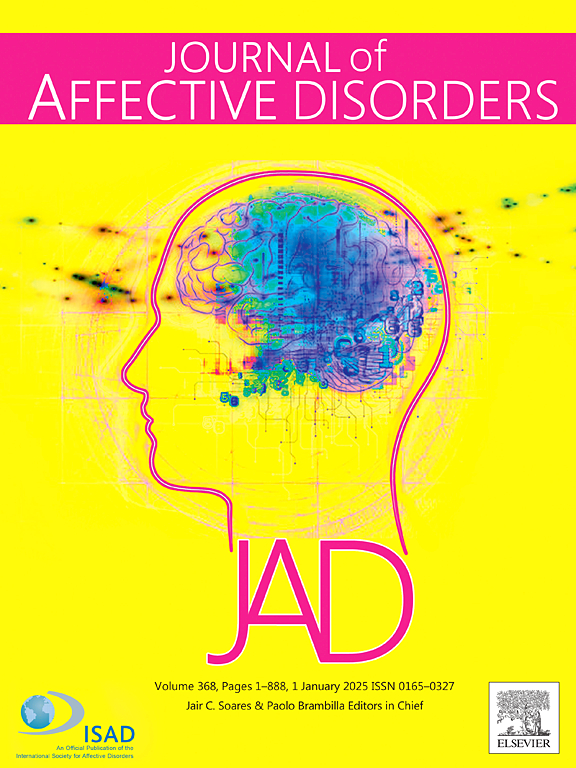Trajectories of depressive and anxiety symptoms throughout pregnancy in relation to obstetric outcomes
IF 4.9
2区 医学
Q1 CLINICAL NEUROLOGY
引用次数: 0
Abstract
Background
High levels of depressive and anxiety symptoms during pregnancy have been linked to adverse pregnancy outcomes. However, it is unclear to what extent this depends on these symptoms' specific change-patterns during pregnancy. Therefore, we aimed to identify different trajectories of depressive and anxiety symptoms during pregnancy and to investigate their associations with obstetric outcomes.
Methods
We administered depression and anxiety questionnaires six times during pregnancy (n = 598) and extracted pregnancy-outcome information from obstetric records. We used growth mixture modeling (GMM) to estimate different depressive- and anxiety-symptom course-trajectories and multivariable regression analyses to investigate their associations with pregnancy outcomes, adjusting for known risk factors (e.g., smoking).
Results
GMM identified four depressive-symptom and three anxiety-symptom trajectory-classes. Only depression trajectories showed associations with obstetric outcomes. Compared with a trajectory-class with stable low depression scores, a class with high and then decreasing scores showed a lower mean gestational age at delivery, and a class with stable moderate scores showed a higher mean birthweight and less frequent low Apgar scores. Overall, trajectory-classes showed limited associations with obstetric outcomes compared with the included known risk factors.
Limitations
The depression questionnaire applied may overestimate depression in pregnancy because it covers many somatic symptoms. The range of obstetric outcomes was limited.
Conclusions
Depressive-symptom course-trajectories during pregnancy were associated with some obstetric outcomes. However, their associations with obstetric risk seemed limited compared with known risk factors (e.g., smoking, primiparity), stressing the importance of considering a full range of factors when aiming to predict obstetric risk in research and practice.
妊娠期间抑郁和焦虑症状的轨迹与产科结局的关系
背景:怀孕期间高水平的抑郁和焦虑症状与不良妊娠结局有关。然而,目前尚不清楚这在多大程度上取决于这些症状在怀孕期间的具体变化模式。因此,我们的目的是确定怀孕期间抑郁和焦虑症状的不同轨迹,并调查其与产科结局的关系。方法对598例妊娠期妇女进行6次抑郁和焦虑问卷调查,并从产科记录中提取妊娠结局信息。我们使用生长混合模型(GMM)来估计不同的抑郁和焦虑症状的病程轨迹,并使用多变量回归分析来研究它们与妊娠结局的关系,调整已知的危险因素(如吸烟)。结果gmm识别出4种抑郁症状和3种焦虑症状轨迹。只有抑郁轨迹与产科结果相关。与抑郁得分稳定的低轨迹组相比,抑郁得分高后下降的轨迹组分娩时平均胎龄较低,抑郁得分稳定中等的轨迹组平均出生体重较高,低阿普加得分较少。总体而言,与已知危险因素相比,轨迹分类显示与产科结局的关联有限。应用抑郁问卷可能会高估孕期抑郁,因为它涵盖了许多躯体症状。产科结果的范围有限。结论妊娠期抑郁症状病程轨迹与部分产科结局相关。然而,与已知的风险因素(如吸烟、初产)相比,它们与产科风险的关联似乎有限,这强调了在研究和实践中预测产科风险时考虑各种因素的重要性。
本文章由计算机程序翻译,如有差异,请以英文原文为准。
求助全文
约1分钟内获得全文
求助全文
来源期刊

Journal of affective disorders
医学-精神病学
CiteScore
10.90
自引率
6.10%
发文量
1319
审稿时长
9.3 weeks
期刊介绍:
The Journal of Affective Disorders publishes papers concerned with affective disorders in the widest sense: depression, mania, mood spectrum, emotions and personality, anxiety and stress. It is interdisciplinary and aims to bring together different approaches for a diverse readership. Top quality papers will be accepted dealing with any aspect of affective disorders, including neuroimaging, cognitive neurosciences, genetics, molecular biology, experimental and clinical neurosciences, pharmacology, neuroimmunoendocrinology, intervention and treatment trials.
 求助内容:
求助内容: 应助结果提醒方式:
应助结果提醒方式:


